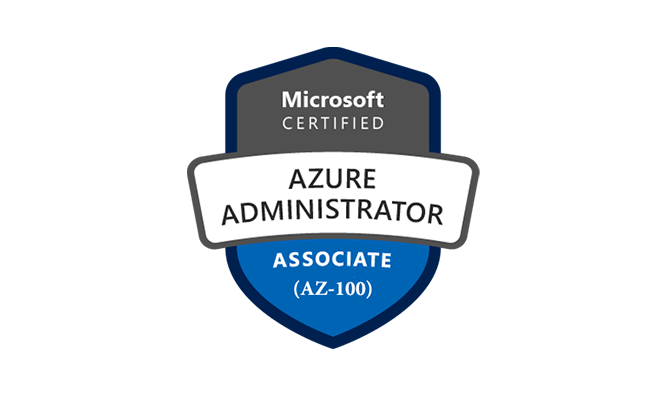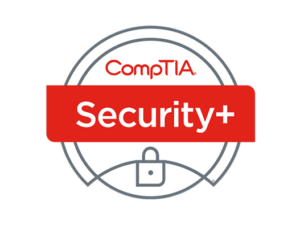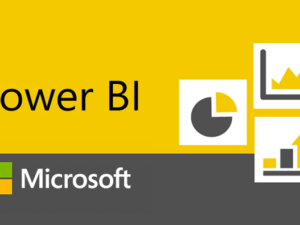Microsoft Certified Associate: Azure Administrator (AZ-100) is designed to help you prepare for the Microsoft Azure Infrastructure and Deployment (AZ-100) Exam – Part of Azure Administrator Badge (Associate-level). You will be able to effectively Setup, Deploy and Scale Azure Virtual Machines, Configure Storage and Virtual Networks, Secure and Monitor the Cloud Infrastructure through robust implementations.
Microsoft Certified Associate: Azure Administrator (AZ-100)
- Description
- Curriculum
- FAQ
- Reviews

Certs Learning’s Azure AZ-100 training provides you an associate-level insight into different services of Microsoft Azure such as Storage, Virtual Machines, Websites, Cloud Services, Azure Active Directory, Virtual Networks, Backup & Site Recovery through a Hands-On. You will be able to Deploy, Configure, Monitor, and Diagnose Cloud Services, Create and manage Azure AD tenants and Configure Application Integration with Azure AD.
- IT Administrators looking for hands-on training on Azure Infrastructure
- Professionals willing to attain Microsoft Certified Azure Administrator Badge
- New entrepreneurs/companies who wishes to build their Infrastructure solution on the cloud at a fraction of the cost of traditional methods
- Cloud Evangelists
- Work experience in IT Administration
- Fundamentals of Cloud Computing
- Basic understanding of virtualization, networking & databases
- Proficiency in using PowerShell and Command-Line Interface
-
1Managing Azure Subscriptions and Resource Groups
Learning Objective: In this module, you will learn about the administrative tools and components that make up an Azure subscription. You will also learn about how resources are organized into resource groups and how ARM templates are used to deploy those resources.
Topics:
- Overview of Azure Subscriptions
- Billing
- Azure Policy
- ARM templates
- Resource Groups
- Azure Portal
- Azure Tools and Environment
Hands On:
- Create an Azure account
- Manage subscriptions. Billing and Policies
- Deploy Resources with ARM Templates
- Manage resources in a Resource group
- Use Portal, PowerShell, CloudShell and CLI to deploy and manage Resources on Azure
-
2Access Management and Monitoring for Cloud Resources
Learning Objective: In this module you will learn the basics of role-based access control as it applies to users and groups. You will also learn about the Azure Monitor and its capabilities to ensure your Azure architecture is working correctly, such as Azure Alerts and Activity Log.
Topics:
- Azure Users and Groups
- Role-based Access Control
- Exploring Monitoring Capabilities in Azure
- Azure Alerts
- Azure Activity Log
- Introduction to Log Analytics
- Querying and Analyzing Log Analytics Data
Hands On:
- Create and manage Users and Groups in Azure
- Implement RBAC
- Configure Alerts using Azure Monitor
- Review Azure Activity Log
- Query and analyze Log Analytics data
-
3Overview of Azure Storage Services
Learning Objective: In this module, you will learn about storage accounts – Standard and Premium – as well as storage endpoints. You will also learn about the types of disks and storage and how Azure blob storage stores unstructured data in the cloud as objects. You will explore Azure Files and understand the structured storage types - Table and Queue storage.
Topics:
- Azure storage accounts
- Data replication
- Azure Storage Explorer
- Virtual machine storage
- Blob storage
- Azure files
- Structured storage
Hands On:
- Create Azure Storage accounts
- Implement Data replication
- Manage storage using Azure Storage Explorer
- Implement VM Storage
- Implement Blobs and Files storages
- Implement Table and Queue storage types
-
4Secure, Manage and Monitor Azure Storage
Learning Objective: In this module, you will discover how a shared access signature (SAS) can be used to provide delegated access to resources in storage accounts. You will also learn how to use Azure backup as a cloud-based solution for an existing on-premises or off-site backup and using CDN to deliver cached content that is stored on a distributed network of edge servers closer to end-users.
Topics:
- Shared access keys
- Azure Backup
- Azure File Sync
- Azure Content Delivery Network
- Import and Export service
- Metrics and Alerts
- Activity Log
Hands On:
- Secure storage using SAS
- Implement Azure Backup service
- Workaround Azure File Sync
- Store and access data using Azure CDN service
- Transfer data using Azure Import/Export service
- Monitor resource health using Metrics and Alerts
- Search and query for events using Activity Log
-
5Overview of Azure Virtual Machines
Learning Objective: In this module, you will be introduced to Azure VMs and their resources. You will also learn how to create and configure custom VMs in Azure.
Topics:
- Azure Virtual Machines Overview
- Planning Considerations
- Overview of VM Creation
- Creating VMs in the Azure Portal
- Creating VMs through PowerShell
- Creating VM using ARM Templates
- Deploying Custom Images
- Deploying Linux VMs
Hands On:
- Create Windows VMs in the Azure Portal
- Create Windows VMs with Azure PowerShell
- Create Windows VMs using ARM Templates
- Deploy custom server images and Linux VMs
-
6Configure and Monitor Virtual Machines for High Availability
Learning Objective: In this module, you will learn about the two main configuration areas for VMs: networking and storage. You will learn how to keep your VMs highly available with update and fault domains, and availability sets. Also, learn how VMs can be extended through custom scripts and Desired State Configuration.
Topics:
- Overview of VM Configuration
- VM Networking
- VM Storage
- VM Availability
- VM Scalability
- Applying VM Extensions
- Backup and Restore
- VM monitoring and diagnostics
- Azure Advisor
Hands On:
- Configure VM networking
- Configure VM storage options
- Implement High Availability
- Implement Scalability using VMSS
- Apply VM Extensions using Custom Scripts and PowerShell DSC (Desired State Configuration)
- Implement Backup and Restore
- Monitor VMs
-
7Overview of Azure Virtual Networks
Learning Objective: In this module, you will be introduced to Azure Virtual Networks and ways to create and configure them. Also, you will learn about Network Security Groups (NSGs) including NSG rules and NSG scenarios. You will learn how to implement NSGs considering service endpoints. This module also deals with DNS basics and implementing Azure DNS.
Topics:
- Introducing Virtual Networks
- Creating Azure Virtual Networks
- Review of IP Addressing
- Azure DNS Basics
- Implementing Azure DNS
- Introduction to Network Security Groups
- Implementing Network Security Groups and Service Endpoints
- Configure Azure Storage Firewalls
Hands On:
- Create and configure Virtual Networks
- Implement Azure DNS
- Configure NSG considering service endpoints
-
8Azure Virtual Network Security and Connectivity
Learning Objective: In this module, you will primarily learn about how system routes, routing tables, and routing algorithms used. This module also deals with Virtual Network peering. Also, you will implement VPN Gateway connectivity: Site-to-Site connections, Point-to-Site connections and VNet-to-VNet connections.
Topics:
- Introduction to Network Security Groups
- Implementing Network Security Groups and Service Endpoints
- VPN Gateway Connections
- Site-to-Site and Multi-Site Connections
- Point-to-Site Connections
- VNet-to-VNet Connections
- Virtual Network Peering
Hands On:
- Configure Virtual Network routing
- Configure BGP On Azure VPN Gateways
- Implement VNet-to-VNet connections
- Implement Virtual Network Peering
-
9Manage Azure Active Directory (AD)
Learning Objective: In this module, you will be introduced to Azure Active Directory and the basics of implementing Azure AD objects. These objects include domains and tenants, users and groups, roles, and devices. In each lesson you will practice how to configure these objects through the portal and with Azure PowerShell.
Topics:
- Azure Active Directory Overview
- Self-Service Password Reset
- Azure AD Identity Protection
- Integrating SaaS Applications with Azure AD
- Azure Domains and Tenants
- Azure Users and Groups
- Azure Roles
- Managing Devices
Hands On:
- Implement Azure Active Directory
- Configure Self-Service Password Reset
- Implement Azure AD Identity Protection
- Configure integrated SaaS applications
- Configure domains and tenants, users and groups
- Manage roles and devices
-
10Implementing and Managing Hybrid Identities
Learning Objective: In this module, you will learn about various authentication options like Password Hash Sync, Single Sign-On, and Pass-through authentication. This module also deals with Azure AD Connect and AD Connect Health. Towards the end, you will also learn how to configure Azure AD Application Proxy and enable password writeback.
Topics:
- Azure AD Connect
- Cloud Authentication Methods: Password Hash Sync, Pass-through Authentication and Federation Integration
- Seamless Single Sign-on
- Azure AD Connect Sync
- Azure AD Connect Health
- Azure AD Application Proxy
- Password Writeback
Hands On:
- Configure Azure AD Connect
- Implement hybrid identity authentication methods
- Configure remote access through Azure AD Application Proxy
- Manage Azure AD Connect Health operations
View the recorded session of the class available in your LMS.
You can attend the missed session, in any other live batch."







